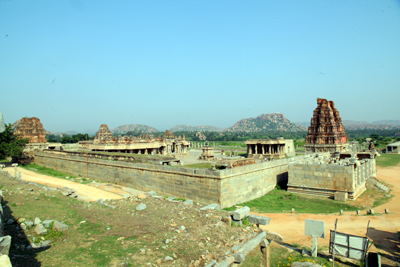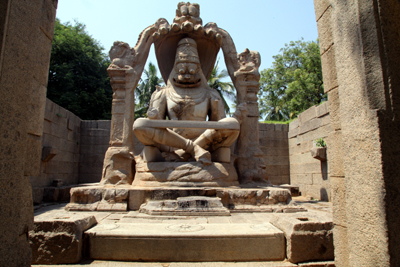Hampi Part 2

Padmanabhaswamy Temple of Thiruvananthapuram is built in the same model as that of Achyutaraya Temple of Hampi. These 2 are built in 2 different decades. The architectural works of Achyutaraya Temple are mesmerizing. Lively statues and carvings done on each stone are capable of capturing the complete attention of the viewer.

The limbs and heads of most of the statues are in a damaged state at present. It shows how cruel and careless mankind has become. I passed through the extensive market in the front and went ahead to visit another important temple, the Vittala Temple.

On one side of the temple, there is a pond enclosed beautifully on all 4 sides. The pond is full of delicate carvings. There are so many ponds like this in Hampi. Anjaneya Hill can be seen on the way to Vittala Temple. There lie on roadsides the ruins of floors of edifices and huge single-stone pillars of ages back. It is rightly called Vittala Temple Complex instead of just Vittala Temple.

An iconic stone chariot on the eastern side welcomes us. The wheels of this exquisite chariot are made of stone. Another major attraction of this place is the ceremonial hall [mandapam] made of 1000 stones. It has musical pillars.
Vittala Temple is the center point where strength of architectural skills and beauty of sculpting come together and meet. Its outstanding beauty cannot be described in words.

When taking the way to Vittala Temple from Kamalapuri, there is a Jain temple on the way. Its craftsmanship is totally different from others. From there, I went on to visit the Queen’s Bath which was built by the king for his first wife, Tirumala Chinnambika. It is an ornate structure, the uniqueness and architectural excellence of which amazes the viewer. The Maha Navami Mandap is near to this.

This ceremonial hall has the height of a 2-storied building. In olden days, kings used to sit on top in the mandap to watch festival celebrations like Dasara. There lie 2 huge granite doors which are said to be the ones used at the entrance. These doors are surprisingly beautiful.

From there, I went to Hazara Rama Temple which is also a creation that indicates the completeness of architectural art. It is a bitter experience to see the destroyed heads of the beautiful statues that stand on the top portion of the entrance to the temple. Most of the walls in Hampi have carvings depicting pictures related to palatial and normal lives.

Lotus Mahal is one of the unique structures of Hampi that is least destroyed. It is built using bricks and lime mortar. Unlike the other structures in Hampi, Lotus Mahal has been given a Mughal touch in its construction. From the top, it looks like a lotus. It is one of the most beautiful structures with interiors surrounded with decorative arches.

Elephant Stables stand next to this. It is built in such a way that 11 elephants can be parked at a time. There is a small museum near this, where the structures that had lied scattered across Hampi are placed along with their names.

At a short distance from here is situated the Karnataka Department Archaeology Museum. Near this is the underground Shiva Temple. Here, the temple and the idol of Lord Shiva stand in knee-deep water. Next, I went to visit the single-stone statue of Narasimha Murthi, which is the largest in Hampi.

Near to this, there is a large single-stone Shivalinga too. Hampi is a storehouse of numerous sights that cannot be counted. Because of shortage of time, I decided in my mind to get satisfied with what I saw and to visit this place of myths again.

Read more about this, Hampi Part 1 here.









